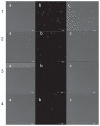Visualization of gold and platinum nanoparticles interacting with Salmonella enteritidis and Listeria monocytogenes
- PMID: 20856838
- PMCID: PMC2939708
- DOI: 10.2147/IJN.S12361
Visualization of gold and platinum nanoparticles interacting with Salmonella enteritidis and Listeria monocytogenes
Abstract
Purpose: Rapid development of nanotechnology has recently brought significant attention to the extraordinary biological features of nanomaterials. The objective of the present investigation was to evaluate morphological characteristics of the assembles of gold and platinum nanoparticles (nano-Au and nano-Pt respectively), with Salmonella Enteritidis (Gram-negative) and Listeria monocytogenes (Gram-positive), to reveal possibilities of constructing bacteria-nanoparticle vehicles.
Methods: Hydrocolloids of nano-Au or nano-Pt were added to two bacteria suspensions in the following order: nano-Au + Salmonella Enteritidis; nano-Au + Listeria monocytogenes; nano-Pt + Salmonella Enteritidis; nano-Pt + Listeria monocytogenes. Samples were inspected by transmission electron microscope.
Results: Visualization of morphological interaction between nano-Au and Salmonella Enteritidis and Listeria monocytogenes, showed that nano-Au were aggregated within flagella or biofilm network and did not penetrate the bacterial cell. The analysis of morphological effects of interaction of nano-Pt with bacteria revealed that nano-Pt entered cells of Listeria monocytogenes and were removed from the cells. In the case of Salmonella Enteritidis, nano-Pt were seen inside bacteria cells, probably bound to DNA and partly left bacterial cells. After washing and centrifugation, some of the nano-Pt-DNA complexes were observed within Salmonella Enteritidis.
Conclusion: The results indicate that the bacteria could be used as a vehicle to deliver nano-Pt to specific points in the body.
Keywords: bacteria; gold; morphology; nanoparticles; platinum.
Figures







Similar articles
-
Visualisation of morphological interaction of diamond and silver nanoparticles with Salmonella Enteritidis and Listeria monocytogenes.J Nanosci Nanotechnol. 2011 Sep;11(9):7635-41. doi: 10.1166/jnn.2011.4735. J Nanosci Nanotechnol. 2011. PMID: 22097468
-
Adhesion of Salmonella Enteritidis and Listeria monocytogenes on stainless steel welds.Int J Food Microbiol. 2014 Nov 17;191:103-8. doi: 10.1016/j.ijfoodmicro.2014.09.003. Epub 2014 Sep 16. Int J Food Microbiol. 2014. PMID: 25261827
-
Visualization of interaction between inorganic nanoparticles and bacteria or fungi.Int J Nanomedicine. 2010 Dec 6;5:1085-94. doi: 10.2147/IJN.S13532. Int J Nanomedicine. 2010. PMID: 21270959 Free PMC article.
-
The prospect of using nanotechnology to prevent and treat infections caused by Listeria monocytogenes.Crit Rev Microbiol. 2025 Jan 15:1-9. doi: 10.1080/1040841X.2025.2452571. Online ahead of print. Crit Rev Microbiol. 2025. PMID: 39810637 Review.
-
Recent advances in improved efficacies of gold nano-formulations in treatment of skin cancer: a systematic review.Arch Dermatol Res. 2025 Jan 20;317(1):301. doi: 10.1007/s00403-025-03817-8. Arch Dermatol Res. 2025. PMID: 39833557
Cited by
-
Theragnostic application of nanoparticle and CRISPR against food-borne multi-drug resistant pathogens.Mater Today Bio. 2022 May 27;15:100291. doi: 10.1016/j.mtbio.2022.100291. eCollection 2022 Jun. Mater Today Bio. 2022. PMID: 35711292 Free PMC article. Review.
-
The Origin of the Intracellular Silver in Bacteria: A Comprehensive Study using Targeting Gold-Silver Alloy Nanoparticles.Adv Healthc Mater. 2023 Dec;12(30):e2302084. doi: 10.1002/adhm.202302084. Epub 2023 Sep 17. Adv Healthc Mater. 2023. PMID: 37661312 Free PMC article.
-
Functionalized Gold Nanoparticles and Their Biomedical Applications.Nanomaterials (Basel). 2011 Jun 14;1(1):31-63. doi: 10.3390/nano1010031. Nanomaterials (Basel). 2011. PMID: 28348279 Free PMC article. Review.
-
Interaction of graphene family materials with Listeria monocytogenes and Salmonella enterica.Nanoscale Res Lett. 2015 Jan 28;10:23. doi: 10.1186/s11671-015-0749-y. eCollection 2015. Nanoscale Res Lett. 2015. PMID: 25685114 Free PMC article.
-
Unique Properties of Surface-Functionalized Nanoparticles for Bio-Application: Functionalization Mechanisms and Importance in Application.Nanomaterials (Basel). 2022 Apr 13;12(8):1333. doi: 10.3390/nano12081333. Nanomaterials (Basel). 2022. PMID: 35458041 Free PMC article. Review.
References
-
- Ortega J, Vigil CE, Chodkiewicz C. Current progress in targeted therapy for colorectal cancer. Cancer Control. 2010;17(1):7–15. - PubMed
-
- Paukner S, Kohl G, Jalava K, Lubitz W. Sealed bacterial ghosts – novel targeting vehicles for advances drug delivery of water-soluble substances. J Drug Target. 2003;11:151–161. - PubMed
-
- Sawosz E, Grodzik M, Zielińska M, Niemiec T, Olszańska B, Chwalibog A. Nanoparticles of silver do not affect growth, development and DNA oxidative damage in chicken embryos. Arch Geflügelk. 2009;73:208–213.
-
- Sawosz E, Grodzik M, Lisowski P, et al. Hydrocolloids of Ag, Au and Ag/Cu alloy nanoparticles influence inflammatory state at transcriptional level. Bull Vet Inst Pulawy. 2010;54:81–85.
-
- Mukherjee P, Bhattacharya R, Wang P, et al. Antiangiogenic properties of gold nanoparticles. Clin Cancer Res. 2005;11(9):3530–3534. - PubMed
Publication types
MeSH terms
Substances
LinkOut - more resources
Full Text Sources
Other Literature Sources
Molecular Biology Databases

